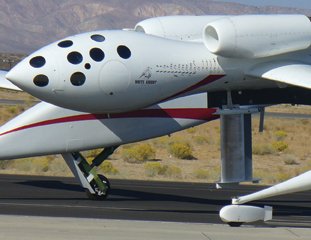12 August 2007
Airplanes of the future might change the shape of their wings as they fly.
Airplane designers have long admired how birds reshape their wings for soaring, diving, and maneuvering.
With Air Force SBIR funding, working prototypes have been built and demonstrated their performance in wind tunnels and in flight.
A prototype aircraft wing has demonstrated , in its first flight tests , that its morphing might save fuel.
A Michigan-based company , FlexSys has created shape-shifting wings that recently performed efficiently in flight tests, And these special wings do more than just look cool. The tests found that aircraft with morphing wings are likely to use less fuel than do traditional airplane designs.

A silver-colored test wing, mounted vertically beneath a jet, has a changeable trailing edge. Its developers completed flight tests of this new wing last month.
High-endurance air vehicles must have the ability to continually adjust the shape of their wings to maximize cruise efficiency as the aircraft burns off fuel and requires less lift.
FlexSys, with funding from Air Force Research Lab's Air Vehicle Directorate, and in coordination with Lockheed Martin, designed a trailing edge flap for a concept high-endurance aircraft wing. Full-scale numerical studies have shown that the technology is weight- and power-competitive with conventional flaps. The compliant trailing edge flap produces a smooth shape change as it deflects from -10° to +10° . Additionally, the flap can twist along the span to tailor wing loading, and can be actuated at rates fast enough to be used as a control surface.
Aeronautical engineers had previously made military jets, such as the F-111, with wings that can change shape. However, heavy hinges and other ponderous hardware , needed for that complex mechanism , made the technology impractical. The old technology, however, is bulky, heavy, and impractical for wide use.
FlexSys, instead, decided to put a specially designed network made of aluminium inside its wings. Aluminium is a lightweight metal. The metal construction flexes on command.
Inside the wing, the metal network bends in response to forces exerted by a simple system of motors and rods. This leads the wing's edge to curve smoothly , either up or down.
During tests inside wind tunnels, the new wings stood up to forces that were three times as strong as those that airplanes normally experience in flight.
In the just-completed flight tests, a jet called the White Knight took a test wing up to altitudes between 8,000 meters (26,300 feet) and 12,000 meters (39,400 feet). The White Knight previously helped launch the first manned, privately built vehicle into outer space .
Once up there, the wing's edge flexed as sensors measured how aerodynamic, or streamlined, it was in various positions.
As an aircraft's fuel is used up, the airplane loses weight, and that changes how aerodynamic the vehicle is. By changing the shape of its wings, a stealth spy plane could reduce drag, save fuel, and stay in flight longer.
References:
http://www.sciencenewsforkids.org/articles/20070103/Note3.asp
Hadir Moftah